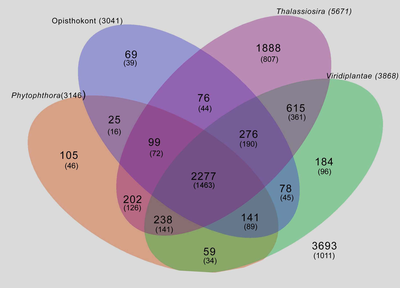OceanRep
Digital expression profiling of novel diatom transcripts provides insight into their biological functions.
Maheswari, Uma, Jabbari, Kamel, Petit, Jean-Louis, Porcel, Betina M, Allen, Andrew E, Cadoret, Jean-Paul, De Martino, Alessandra, Heijde, Marc, Kaas, Raymond, LaRoche, Julie, Lopez, Pascal J, Martin-Jézéquel, Véronique, Meichenin, Agnès, Mock, Thomas, Schnitzler Parker, Micaela, Vardi, Assaf, Armbrust, E Virginia, Weissenbach, Jean, Katinka, Michaël and Bowler, Chris
(2010)
Digital expression profiling of novel diatom transcripts provides insight into their biological functions.
![]() Genome Biology, 11
(8).
R85.
DOI 10.1186/gb-2010-11-8-r85.
Genome Biology, 11
(8).
R85.
DOI 10.1186/gb-2010-11-8-r85.
Preview |
Text
gb-2010-11-8-r85.pdf - Published Version Download (1MB) |
|
Other (Supplementary Table S1. A comprehensive description of culturing conditions of the libraries)
gb-2010-11-8-r85-s1.xls - Supplemental Material Download (35kB) |
|
Preview |
Text (Supplementary Figure S1. Expression patterns of diatom-specific genes. (A) Hierarchical clustering to show the expression pattern of transcripts belonging to the gene families conserved across different taxonomical groups (Core), diatom-specific (Diatom) )
gb-2010-11-8-r85-s2.pdf - Supplemental Material Download (1MB) |
|
Other (Supplementary Table S2. Diatom-specific genes expressed in both high and low decadienal libraries (HD and LD))
gb-2010-11-8-r85-s3.xls - Supplemental Material Download (45kB) |
|
|
Other (Supplementary Table S3. R-values of the actual 9,145 clusters and that of the randomized data set)
gb-2010-11-8-r85-s4.xls - Supplemental Material Download (29kB) |
|
Preview |
Text (Supplementary Figure S2. Percentage of differentially expressed transcripts in primary y-axis, normalized to number of non-redundant transcripts (TUs) across the EST libraries and the percentage of transcripts with defined InterPro domains (PDFs) in the d)
gb-2010-11-8-r85-s5.pdf - Supplemental Material Download (1MB) |
|
Other (Supplementary Table S4. The 71 transcripts that were expressed at least once across all the libraries. )
gb-2010-11-8-r85-s6.xls - Supplemental Material Download (38kB) |
|
|
Other (Supplementary Table S5. GO terms that are over-represented in each library (P < 0.001). In this table we also show over-represented GO terms shared between libraries)
gb-2010-11-8-r85-s7.xls - Supplemental Material Download (77kB) |
|
![[thumbnail of Supplementary Figure S3. Distribution of P. tricornutum PDFs in other organismal groups. Numbers in parentheses indicate the number of genes with defined protein domains (PDF) and the number outside the parentheses represent the total number of genes in e]](https://oceanrep.geomar.de/10980/9.hassmallThumbnailVersion/gb-2010-11-8-r85-s8.jpeg)  Preview |
Image (Supplementary Figure S3. Distribution of P. tricornutum PDFs in other organismal groups. Numbers in parentheses indicate the number of genes with defined protein domains (PDF) and the number outside the parentheses represent the total number of genes in e)
gb-2010-11-8-r85-s8.jpeg - Supplemental Material Download (209kB) |
|
Other (Supplementary Table S6. The top 20 IPR domains expressed across all the libraries and the number of ESTs for each domain)
gb-2010-11-8-r85-s9.xls - Supplemental Material Download (50kB) |
|
Preview |
Text (Supplementary Figure S4. Hierarchical clustering of transcripts defined as being differentially expressed under the nitrate starved condition (NS) in P. tricornutum along with the hierarchical clustering of corresponding orthologs expressed in the nitrate)
gb-2010-11-8-r85-s10.pdf - Supplemental Material Download (1MB) |
Preview |
Text (Supplementary Figure S5. Hierarchical clustering showing the expression patterns of P. tricornutum orthologs of the novel genes identified by tiling array in T. pseudonana [42] . Expression levels are shown in an increasing scale from grey to dark blue, a)
gb-2010-11-8-r85-s11.pdf - Supplemental Material Download (949kB) |
Preview |
Text (Supplementary Figure S6. Expression of bacterial orthologous genes in P. tricornutum. (A) Plot showing the number of transcripts of bacterial origin expressed across the 16 different growth conditions. The primary y-axis shows the number of transcripts an)
gb-2010-11-8-r85-s12.pdf - Supplemental Material Download (1MB) |
|
Other (Supplementary Figure S6. Expression of bacterial orthologous genes in P. tricornutum. (A) Plot showing the number of transcripts of bacterial origin expressed across the 16 different growth conditions. The primary y-axis shows the number of transcripts an)
gb-2010-11-8-r85-s13.xls - Supplemental Material Download (225kB) |
Abstract
Background:
Diatoms represent the predominant group of eukaryotic phytoplankton in the oceans and are responsible for around 20% of global photosynthesis. Two whole genome sequences are now available. Notwithstanding, our knowledge of diatom biology remains limited because only around half of their genes can be ascribed a function based onhomology-based methods. High throughput tools are needed, therefore, to associate functions with diatom-specific genes.
Results:
We have performed a systematic analysis of 130,000 ESTs derived from Phaeodactylum tricornutum cells grown in 16 different conditions. These include different sources of nitrogen, different concentrations of carbon dioxide, silicate and iron, and abiotic stresses such as low temperature and low salinity. Based on unbiased statistical methods, we have catalogued transcripts with similar expression profiles and identified transcripts differentially expressed in response to specific treatments. Functional annotation of these transcripts provides insights into expression patterns of genes involved in various metabolic and regulatory pathways and into the roles of novel genes with unknown functions. Specific growth conditions could be associated with enhanced gene diversity, known gene product functions, and over-representation of novel transcripts. Comparative analysis of data from the other sequenced diatom, Thalassiosira pseudonana, helped identify several unique diatom genes that are specifically regulated under particular conditions, thus facilitating studies of gene function, genome annotation and the molecular basis of species diversity.
Conclusions:
The digital gene expression database represents a new resource for identifying candidate diatom-specific genes involved in processes of major ecological relevance.
| Document Type: | Article |
|---|---|
| Keywords: | Marine Biology; phytoplankton |
| Research affiliation: | OceanRep > GEOMAR > FB2 Marine Biogeochemistry > FB2-BI Biological Oceanography |
| Refereed: | Yes |
| Open Access Journal?: | Yes |
| Publisher: | BioMed Central |
| Date Deposited: | 09 Feb 2011 12:39 |
| Last Modified: | 22 Jan 2019 09:36 |
| URI: | https://oceanrep.geomar.de/id/eprint/10980 |
Actions (login required)
 |
View Item |
Copyright 2023 | GEOMAR Helmholtz-Zentrum für Ozeanforschung Kiel | All rights reserved
Questions, comments and suggestions regarding the GEOMAR repository are welcomed
at bibliotheksleitung@geomar.de !


 Tools
Tools Tools
Tools
